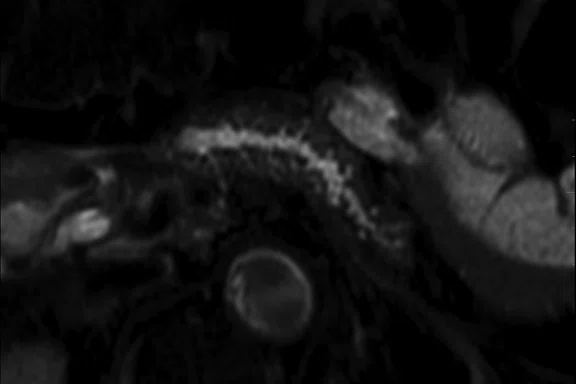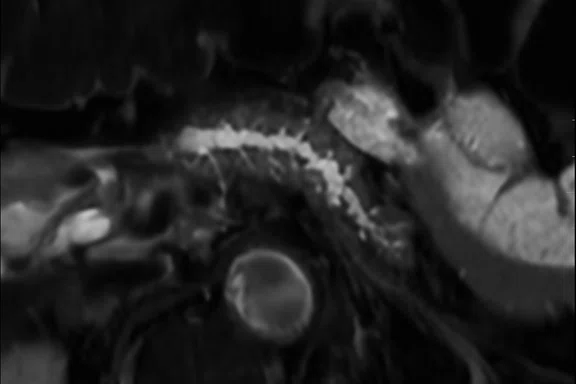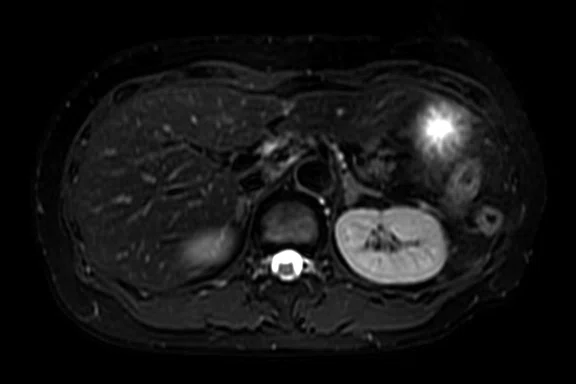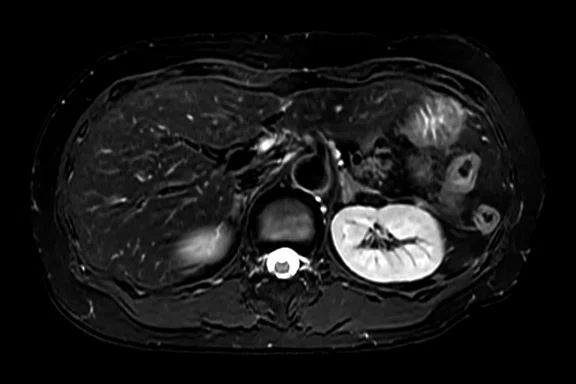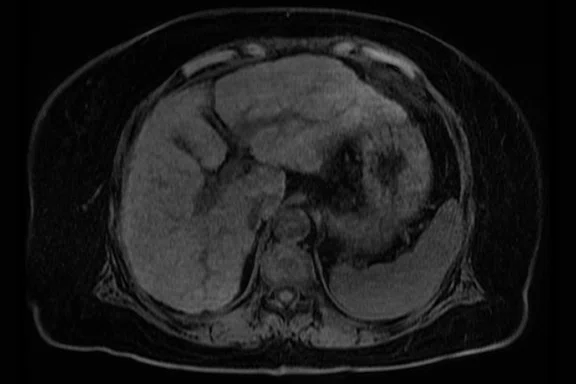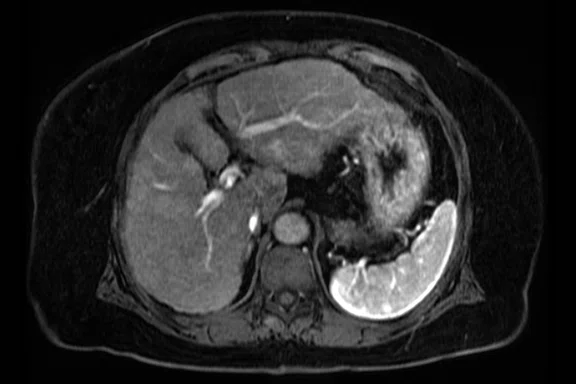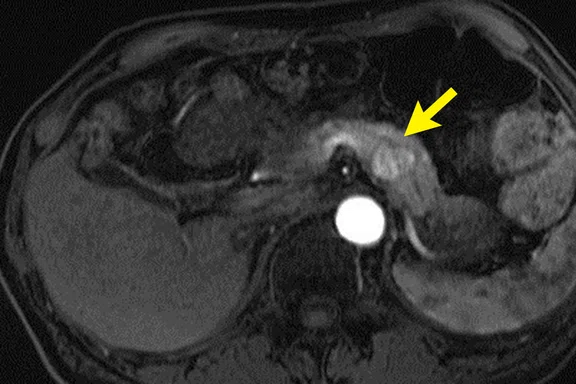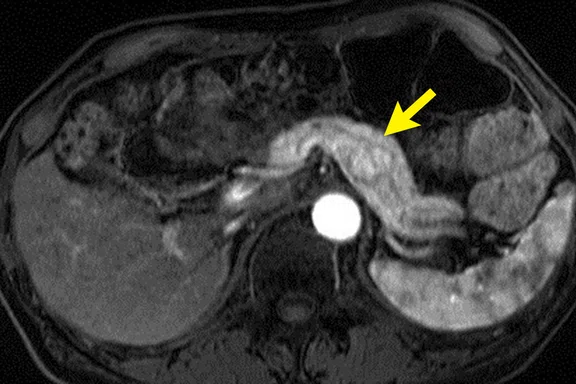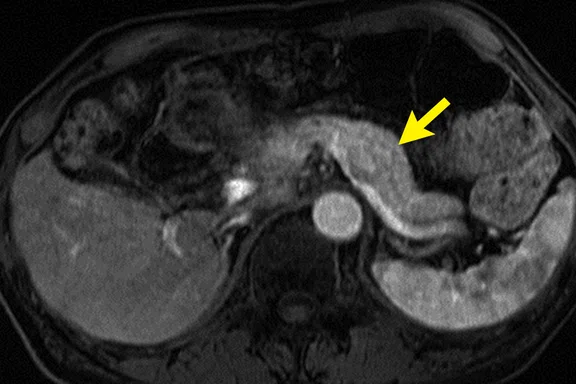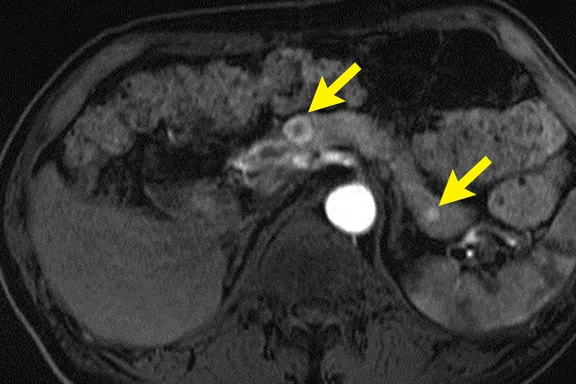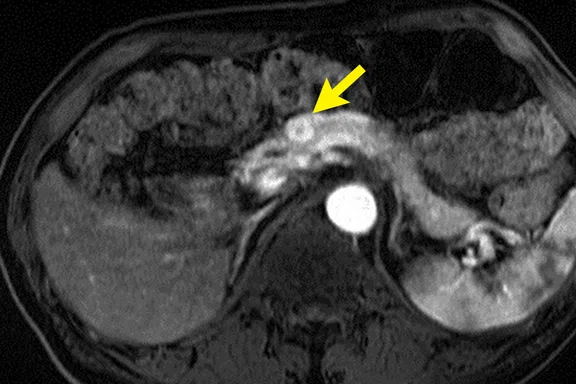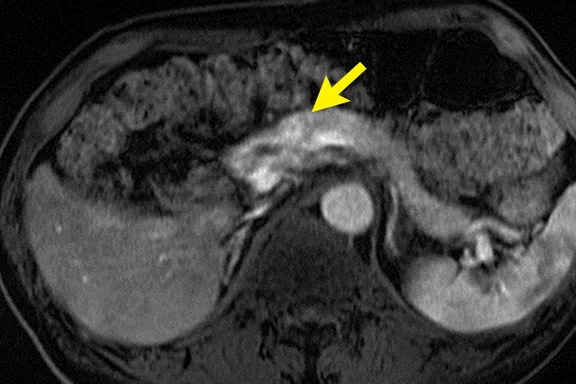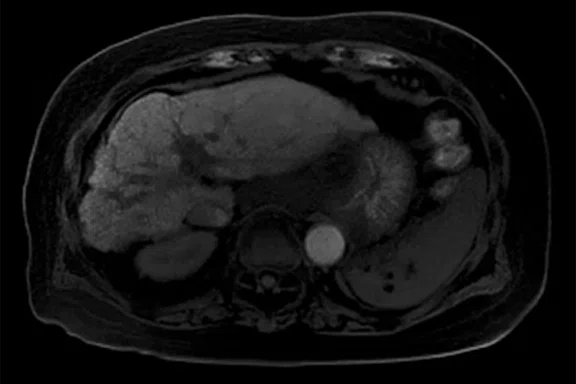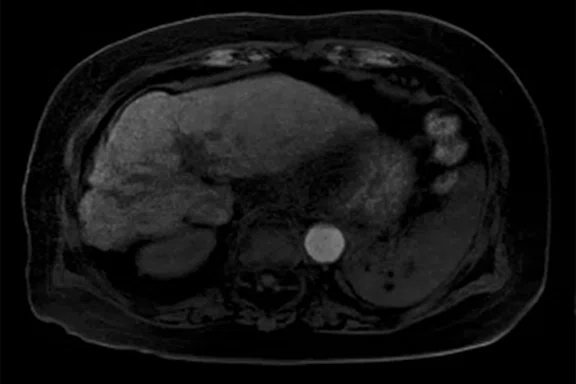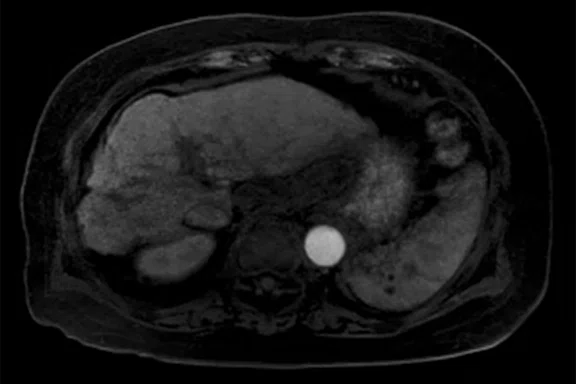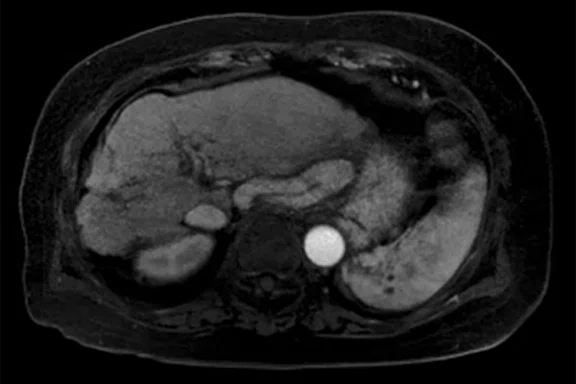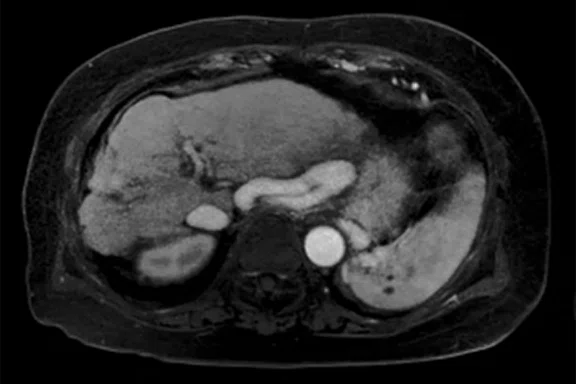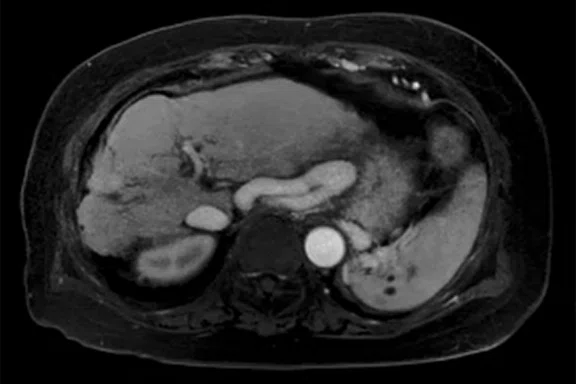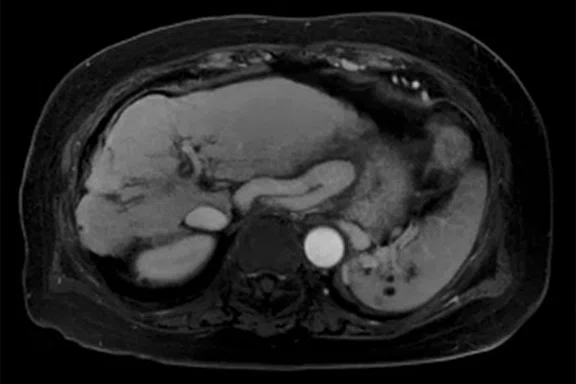result
A
Figure 1.
AIR™ Recon DL improves visualization of the main pancreatic duct. (A) Conventional reconstruction and (B) with AIR™ Recon DL.
B
Figure 1.
AIR™ Recon DL improves visualization of the main pancreatic duct. (A) Conventional reconstruction and (B) with AIR™ Recon DL.
A
Figure 2.
AIR™ Recon DL can improve spatial resolution while reducing scan time. (A) Conventional reconstruction, 1.1 x 1.8 x 5 mm, 2:00 min. and (B) with AIR™ Recon DL, 0.8 x 1.8 x 5mm, 1:05 min.
B
Figure 2.
AIR™ Recon DL can improve spatial resolution while reducing scan time. (A) Conventional reconstruction, 1.1 x 1.8 x 5 mm, 2:00 min. and (B) with AIR™ Recon DL, 0.8 x 1.8 x 5mm, 1:05 min.
A-1
Figure 3.
(A) Conventional reconstruction, 1.1 x 1.8 x 5 mm and (B) with AIR™ ReconDL, 0.8 x 1.8 x 2.5mm.
B-1
Figure 3.
(A) Conventional reconstruction, 1.1 x 1.8 x 5 mm and (B) with AIR™ ReconDL, 0.8 x 1.8 x 2.5mm.
A-2
Figure 3.
(A) Conventional reconstruction, 1.1 x 1.8 x 5 mm and (B) with AIR™ ReconDL, 0.8 x 1.8 x 2.5mm.
B-2
Figure 3.
(A) Conventional reconstruction, 1.1 x 1.8 x 5 mm and (B) with AIR™ ReconDL, 0.8 x 1.8 x 2.5mm.
A
Figure 4.
Using LAVA with HyperSense enables three phases in one breath-hold. (A) Mask, (B) 1st phase at 0 sec., (C) 2nd phase at 2.98 sec. and (D) 3rd phase at 5.97 sec.
B
Figure 4.
Using LAVA with HyperSense enables three phases in one breath-hold. (A) Mask, (B) 1st phase at 0 sec., (C) 2nd phase at 2.98 sec. and (D) 3rd phase at 5.97 sec.
C
Figure 4.
Using LAVA with HyperSense enables three phases in one breath-hold. (A) Mask, (B) 1st phase at 0 sec., (C) 2nd phase at 2.98 sec. and (D) 3rd phase at 5.97 sec.
D
Figure 4.
Using LAVA with HyperSense enables three phases in one breath-hold. (A) Mask, (B) 1st phase at 0 sec., (C) 2nd phase at 2.98 sec. and (D) 3rd phase at 5.97 sec.
A
Figure 5.
A 50-year-old man with a metastatic pancreas tumor from renal cell carcinoma. Using HyperSense to add more arterial phases enables detection of another metastasis in the tail of the pancreas (arrows).
B
Figure 5.
A 50-year-old man with a metastatic pancreas tumor from renal cell carcinoma. Using HyperSense to add more arterial phases enables detection of another metastasis in the tail of the pancreas (arrows).
C
Figure 5.
A 50-year-old man with a metastatic pancreas tumor from renal cell carcinoma. Using HyperSense to add more arterial phases enables detection of another metastasis in the tail of the pancreas (arrows).
D
Figure 5.
A 50-year-old man with a metastatic pancreas tumor from renal cell carcinoma. Using HyperSense to add more arterial phases enables detection of another metastasis in the tail of the pancreas (arrows).
E
Figure 5.
A 50-year-old man with a metastatic pancreas tumor from renal cell carcinoma. Using HyperSense to add more arterial phases enables detection of another metastasis in the tail of the pancreas (arrows).
F
Figure 5.
A 50-year-old man with a metastatic pancreas tumor from renal cell carcinoma. Using HyperSense to add more arterial phases enables detection of another metastasis in the tail of the pancreas (arrows).
A-1
Figure 6.
(A) Conventional DISCO acquisition, 320 x 192 in 23 sec.; (B) DISCO with HyperSense, 320 x 192 in 20 sec., offers less-than-3-second temporal resolution in one breath-hold and the acquisition of an additional phase in less time than the conventional acquisition. (C) Conventional LAVA, 320 x 160 in 20 sec.; (D-F) LAVA with HyperSense, 320 x 192, 24 sec., also enables additional phase acquisitons in less time than conventional LAVA.
B-1
Figure 6.
(A) Conventional DISCO acquisition, 320 x 192 in 23 sec.; (B) DISCO with HyperSense, 320 x 192 in 20 sec., offers less-than-3-second temporal resolution in one breath-hold and the acquisition of an additional phase in less time than the conventional acquisition. (C) Conventional LAVA, 320 x 160 in 20 sec.; (D-F) LAVA with HyperSense, 320 x 192, 24 sec., also enables additional phase acquisitons in less time than conventional LAVA.
A
Figure 7.
Using DISCO Star with HyperSense, we can perform a continuous 90-second scan acquiring six phases with a temporal resolution around 12 seconds without breath hold. Acquisition parameters are, 1.1 x 1.8 x 3.6 mm. (A) Mask, (B) 1st phase at 0 sec (C) 2nd phase at 12.45 sec., (D) 3rd phase at 24.89 sec., (E) 4th phase at 37.34 sec., (F) 5th phase at 49.78 sec. and (G) 6th phase at 87.12 sec.
B
Figure 7.
Using DISCO Star with HyperSense, we can perform a continuous 90-second scan acquiring six phases with a temporal resolution around 12 seconds without breath hold. Acquisition parameters are, 1.1 x 1.8 x 3.6 mm. (A) Mask, (B) 1st phase at 0 sec (C) 2nd phase at 12.45 sec., (D) 3rd phase at 24.89 sec., (E) 4th phase at 37.34 sec., (F) 5th phase at 49.78 sec. and (G) 6th phase at 87.12 sec.
C
Figure 7.
Using DISCO Star with HyperSense, we can perform a continuous 90-second scan acquiring six phases with a temporal resolution around 12 seconds without breath hold. Acquisition parameters are, 1.1 x 1.8 x 3.6 mm. (A) Mask, (B) 1st phase at 0 sec (C) 2nd phase at 12.45 sec., (D) 3rd phase at 24.89 sec., (E) 4th phase at 37.34 sec., (F) 5th phase at 49.78 sec. and (G) 6th phase at 87.12 sec.
D
Figure 7.
Using DISCO Star with HyperSense, we can perform a continuous 90-second scan acquiring six phases with a temporal resolution around 12 seconds without breath hold. Acquisition parameters are, 1.1 x 1.8 x 3.6 mm. (A) Mask, (B) 1st phase at 0 sec (C) 2nd phase at 12.45 sec., (D) 3rd phase at 24.89 sec., (E) 4th phase at 37.34 sec., (F) 5th phase at 49.78 sec. and (G) 6th phase at 87.12 sec.
E
Figure 7.
Using DISCO Star with HyperSense, we can perform a continuous 90-second scan acquiring six phases with a temporal resolution around 12 seconds without breath hold. Acquisition parameters are, 1.1 x 1.8 x 3.6 mm. (A) Mask, (B) 1st phase at 0 sec (C) 2nd phase at 12.45 sec., (D) 3rd phase at 24.89 sec., (E) 4th phase at 37.34 sec., (F) 5th phase at 49.78 sec. and (G) 6th phase at 87.12 sec.
F
Figure 7.
Using DISCO Star with HyperSense, we can perform a continuous 90-second scan acquiring six phases with a temporal resolution around 12 seconds without breath hold. Acquisition parameters are, 1.1 x 1.8 x 3.6 mm. (A) Mask, (B) 1st phase at 0 sec (C) 2nd phase at 12.45 sec., (D) 3rd phase at 24.89 sec., (E) 4th phase at 37.34 sec., (F) 5th phase at 49.78 sec. and (G) 6th phase at 87.12 sec.
G
Figure 7.
Using DISCO Star with HyperSense, we can perform a continuous 90-second scan acquiring six phases with a temporal resolution around 12 seconds without breath hold. Acquisition parameters are, 1.1 x 1.8 x 3.6 mm. (A) Mask, (B) 1st phase at 0 sec (C) 2nd phase at 12.45 sec., (D) 3rd phase at 24.89 sec., (E) 4th phase at 37.34 sec., (F) 5th phase at 49.78 sec. and (G) 6th phase at 87.12 sec.
A-2
Figure 6.
(A) Conventional DISCO acquisition, 320 x 192 in 23 sec.; (B) DISCO with HyperSense, 320 x 192 in 20 sec., offers less-than-3-second temporal resolution in one breath-hold and the acquisition of an additional phase in less time than the conventional acquisition. (C) Conventional LAVA, 320 x 160 in 20 sec.; (D-F) LAVA with HyperSense, 320 x 192, 24 sec., also enables additional phase acquisitons in less time than conventional LAVA.
A-3
Figure 6.
(A) Conventional DISCO acquisition, 320 x 192 in 23 sec.; (B) DISCO with HyperSense, 320 x 192 in 20 sec., offers less-than-3-second temporal resolution in one breath-hold and the acquisition of an additional phase in less time than the conventional acquisition. (C) Conventional LAVA, 320 x 160 in 20 sec.; (D-F) LAVA with HyperSense, 320 x 192, 24 sec., also enables additional phase acquisitons in less time than conventional LAVA.
A-4
Figure 6.
(A) Conventional DISCO acquisition, 320 x 192 in 23 sec.; (B) DISCO with HyperSense, 320 x 192 in 20 sec., offers less-than-3-second temporal resolution in one breath-hold and the acquisition of an additional phase in less time than the conventional acquisition. (C) Conventional LAVA, 320 x 160 in 20 sec.; (D-F) LAVA with HyperSense, 320 x 192, 24 sec., also enables additional phase acquisitons in less time than conventional LAVA.
A-5
Figure 6.
(A) Conventional DISCO acquisition, 320 x 192 in 23 sec.; (B) DISCO with HyperSense, 320 x 192 in 20 sec., offers less-than-3-second temporal resolution in one breath-hold and the acquisition of an additional phase in less time than the conventional acquisition. (C) Conventional LAVA, 320 x 160 in 20 sec.; (D-F) LAVA with HyperSense, 320 x 192, 24 sec., also enables additional phase acquisitons in less time than conventional LAVA.
A-6
Figure 6.
(A) Conventional DISCO acquisition, 320 x 192 in 23 sec.; (B) DISCO with HyperSense, 320 x 192 in 20 sec., offers less-than-3-second temporal resolution in one breath-hold and the acquisition of an additional phase in less time than the conventional acquisition. (C) Conventional LAVA, 320 x 160 in 20 sec.; (D-F) LAVA with HyperSense, 320 x 192, 24 sec., also enables additional phase acquisitons in less time than conventional LAVA.
B-2
Figure 6.
(A) Conventional DISCO acquisition, 320 x 192 in 23 sec.; (B) DISCO with HyperSense, 320 x 192 in 20 sec., offers less-than-3-second temporal resolution in one breath-hold and the acquisition of an additional phase in less time than the conventional acquisition. (C) Conventional LAVA, 320 x 160 in 20 sec.; (D-F) LAVA with HyperSense, 320 x 192, 24 sec., also enables additional phase acquisitons in less time than conventional LAVA.
B-3
Figure 6.
(A) Conventional DISCO acquisition, 320 x 192 in 23 sec.; (B) DISCO with HyperSense, 320 x 192 in 20 sec., offers less-than-3-second temporal resolution in one breath-hold and the acquisition of an additional phase in less time than the conventional acquisition. (C) Conventional LAVA, 320 x 160 in 20 sec.; (D-F) LAVA with HyperSense, 320 x 192, 24 sec., also enables additional phase acquisitons in less time than conventional LAVA.
B-4
Figure 6.
(A) Conventional DISCO acquisition, 320 x 192 in 23 sec.; (B) DISCO with HyperSense, 320 x 192 in 20 sec., offers less-than-3-second temporal resolution in one breath-hold and the acquisition of an additional phase in less time than the conventional acquisition. (C) Conventional LAVA, 320 x 160 in 20 sec.; (D-F) LAVA with HyperSense, 320 x 192, 24 sec., also enables additional phase acquisitons in less time than conventional LAVA.
B-5
Figure 6.
(A) Conventional DISCO acquisition, 320 x 192 in 23 sec.; (B) DISCO with HyperSense, 320 x 192 in 20 sec., offers less-than-3-second temporal resolution in one breath-hold and the acquisition of an additional phase in less time than the conventional acquisition. (C) Conventional LAVA, 320 x 160 in 20 sec.; (D-F) LAVA with HyperSense, 320 x 192, 24 sec., also enables additional phase acquisitons in less time than conventional LAVA.
B-6
Figure 6.
(A) Conventional DISCO acquisition, 320 x 192 in 23 sec.; (B) DISCO with HyperSense, 320 x 192 in 20 sec., offers less-than-3-second temporal resolution in one breath-hold and the acquisition of an additional phase in less time than the conventional acquisition. (C) Conventional LAVA, 320 x 160 in 20 sec.; (D-F) LAVA with HyperSense, 320 x 192, 24 sec., also enables additional phase acquisitons in less time than conventional LAVA.
B-7
Figure 6.
(A) Conventional DISCO acquisition, 320 x 192 in 23 sec.; (B) DISCO with HyperSense, 320 x 192 in 20 sec., offers less-than-3-second temporal resolution in one breath-hold and the acquisition of an additional phase in less time than the conventional acquisition. (C) Conventional LAVA, 320 x 160 in 20 sec.; (D-F) LAVA with HyperSense, 320 x 192, 24 sec., also enables additional phase acquisitons in less time than conventional LAVA.
C
Figure 6.
(A) Conventional DISCO acquisition, 320 x 192 in 23 sec.; (B) DISCO with HyperSense, 320 x 192 in 20 sec., offers less-than-3-second temporal resolution in one breath-hold and the acquisition of an additional phase in less time than the conventional acquisition. (C) Conventional LAVA, 320 x 160 in 20 sec.; (D-F) LAVA with HyperSense, 320 x 192, 24 sec., also enables additional phase acquisitons in less time than conventional LAVA.
D
Figure 6.
(A) Conventional DISCO acquisition, 320 x 192 in 23 sec.; (B) DISCO with HyperSense, 320 x 192 in 20 sec., offers less-than-3-second temporal resolution in one breath-hold and the acquisition of an additional phase in less time than the conventional acquisition. (C) Conventional LAVA, 320 x 160 in 20 sec.; (D-F) LAVA with HyperSense, 320 x 192, 24 sec., also enables additional phase acquisitons in less time than conventional LAVA.
E
Figure 6.
(A) Conventional DISCO acquisition, 320 x 192 in 23 sec.; (B) DISCO with HyperSense, 320 x 192 in 20 sec., offers less-than-3-second temporal resolution in one breath-hold and the acquisition of an additional phase in less time than the conventional acquisition. (C) Conventional LAVA, 320 x 160 in 20 sec.; (D-F) LAVA with HyperSense, 320 x 192, 24 sec., also enables additional phase acquisitons in less time than conventional LAVA.
F
Figure 6.
(A) Conventional DISCO acquisition, 320 x 192 in 23 sec.; (B) DISCO with HyperSense, 320 x 192 in 20 sec., offers less-than-3-second temporal resolution in one breath-hold and the acquisition of an additional phase in less time than the conventional acquisition. (C) Conventional LAVA, 320 x 160 in 20 sec.; (D-F) LAVA with HyperSense, 320 x 192, 24 sec., also enables additional phase acquisitons in less time than conventional LAVA.
A-1
Figure 6.
(A) Conventional DISCO acquisition, 320 x 192 in 23 sec.; (B) DISCO with HyperSense, 320 x 192 in 20 sec., offers less-than-3-second temporal resolution in one breath-hold and the acquisition of an additional phase in less time than the conventional acquisition. (C) Conventional LAVA, 320 x 160 in 20 sec.; (D-F) LAVA with HyperSense, 320 x 192, 24 sec., also enables additional phase acquisitons in less time than conventional LAVA.
A-2
Figure 6.
(A) Conventional DISCO acquisition, 320 x 192 in 23 sec.; (B) DISCO with HyperSense, 320 x 192 in 20 sec., offers less-than-3-second temporal resolution in one breath-hold and the acquisition of an additional phase in less time than the conventional acquisition. (C) Conventional LAVA, 320 x 160 in 20 sec.; (D-F) LAVA with HyperSense, 320 x 192, 24 sec., also enables additional phase acquisitons in less time than conventional LAVA.
A-3
Figure 6.
(A) Conventional DISCO acquisition, 320 x 192 in 23 sec.; (B) DISCO with HyperSense, 320 x 192 in 20 sec., offers less-than-3-second temporal resolution in one breath-hold and the acquisition of an additional phase in less time than the conventional acquisition. (C) Conventional LAVA, 320 x 160 in 20 sec.; (D-F) LAVA with HyperSense, 320 x 192, 24 sec., also enables additional phase acquisitons in less time than conventional LAVA.
A-4
Figure 6.
(A) Conventional DISCO acquisition, 320 x 192 in 23 sec.; (B) DISCO with HyperSense, 320 x 192 in 20 sec., offers less-than-3-second temporal resolution in one breath-hold and the acquisition of an additional phase in less time than the conventional acquisition. (C) Conventional LAVA, 320 x 160 in 20 sec.; (D-F) LAVA with HyperSense, 320 x 192, 24 sec., also enables additional phase acquisitons in less time than conventional LAVA.
A-5
Figure 6.
(A) Conventional DISCO acquisition, 320 x 192 in 23 sec.; (B) DISCO with HyperSense, 320 x 192 in 20 sec., offers less-than-3-second temporal resolution in one breath-hold and the acquisition of an additional phase in less time than the conventional acquisition. (C) Conventional LAVA, 320 x 160 in 20 sec.; (D-F) LAVA with HyperSense, 320 x 192, 24 sec., also enables additional phase acquisitons in less time than conventional LAVA.
A-6
Figure 6.
(A) Conventional DISCO acquisition, 320 x 192 in 23 sec.; (B) DISCO with HyperSense, 320 x 192 in 20 sec., offers less-than-3-second temporal resolution in one breath-hold and the acquisition of an additional phase in less time than the conventional acquisition. (C) Conventional LAVA, 320 x 160 in 20 sec.; (D-F) LAVA with HyperSense, 320 x 192, 24 sec., also enables additional phase acquisitons in less time than conventional LAVA.
B-1
Figure 6.
(A) Conventional DISCO acquisition, 320 x 192 in 23 sec.; (B) DISCO with HyperSense, 320 x 192 in 20 sec., offers less-than-3-second temporal resolution in one breath-hold and the acquisition of an additional phase in less time than the conventional acquisition. (C) Conventional LAVA, 320 x 160 in 20 sec.; (D-F) LAVA with HyperSense, 320 x 192, 24 sec., also enables additional phase acquisitons in less time than conventional LAVA.
B-2
Figure 6.
(A) Conventional DISCO acquisition, 320 x 192 in 23 sec.; (B) DISCO with HyperSense, 320 x 192 in 20 sec., offers less-than-3-second temporal resolution in one breath-hold and the acquisition of an additional phase in less time than the conventional acquisition. (C) Conventional LAVA, 320 x 160 in 20 sec.; (D-F) LAVA with HyperSense, 320 x 192, 24 sec., also enables additional phase acquisitons in less time than conventional LAVA.
B-3
Figure 6.
(A) Conventional DISCO acquisition, 320 x 192 in 23 sec.; (B) DISCO with HyperSense, 320 x 192 in 20 sec., offers less-than-3-second temporal resolution in one breath-hold and the acquisition of an additional phase in less time than the conventional acquisition. (C) Conventional LAVA, 320 x 160 in 20 sec.; (D-F) LAVA with HyperSense, 320 x 192, 24 sec., also enables additional phase acquisitons in less time than conventional LAVA.
B-4
Figure 6.
(A) Conventional DISCO acquisition, 320 x 192 in 23 sec.; (B) DISCO with HyperSense, 320 x 192 in 20 sec., offers less-than-3-second temporal resolution in one breath-hold and the acquisition of an additional phase in less time than the conventional acquisition. (C) Conventional LAVA, 320 x 160 in 20 sec.; (D-F) LAVA with HyperSense, 320 x 192, 24 sec., also enables additional phase acquisitons in less time than conventional LAVA.
B-5
Figure 6.
(A) Conventional DISCO acquisition, 320 x 192 in 23 sec.; (B) DISCO with HyperSense, 320 x 192 in 20 sec., offers less-than-3-second temporal resolution in one breath-hold and the acquisition of an additional phase in less time than the conventional acquisition. (C) Conventional LAVA, 320 x 160 in 20 sec.; (D-F) LAVA with HyperSense, 320 x 192, 24 sec., also enables additional phase acquisitons in less time than conventional LAVA.
B-6
Figure 6.
(A) Conventional DISCO acquisition, 320 x 192 in 23 sec.; (B) DISCO with HyperSense, 320 x 192 in 20 sec., offers less-than-3-second temporal resolution in one breath-hold and the acquisition of an additional phase in less time than the conventional acquisition. (C) Conventional LAVA, 320 x 160 in 20 sec.; (D-F) LAVA with HyperSense, 320 x 192, 24 sec., also enables additional phase acquisitons in less time than conventional LAVA.
B-7
Figure 6.
(A) Conventional DISCO acquisition, 320 x 192 in 23 sec.; (B) DISCO with HyperSense, 320 x 192 in 20 sec., offers less-than-3-second temporal resolution in one breath-hold and the acquisition of an additional phase in less time than the conventional acquisition. (C) Conventional LAVA, 320 x 160 in 20 sec.; (D-F) LAVA with HyperSense, 320 x 192, 24 sec., also enables additional phase acquisitons in less time than conventional LAVA.
C
Figure 6.
(A) Conventional DISCO acquisition, 320 x 192 in 23 sec.; (B) DISCO with HyperSense, 320 x 192 in 20 sec., offers less-than-3-second temporal resolution in one breath-hold and the acquisition of an additional phase in less time than the conventional acquisition. (C) Conventional LAVA, 320 x 160 in 20 sec.; (D-F) LAVA with HyperSense, 320 x 192, 24 sec., also enables additional phase acquisitons in less time than conventional LAVA.
D
Figure 6.
(A) Conventional DISCO acquisition, 320 x 192 in 23 sec.; (B) DISCO with HyperSense, 320 x 192 in 20 sec., offers less-than-3-second temporal resolution in one breath-hold and the acquisition of an additional phase in less time than the conventional acquisition. (C) Conventional LAVA, 320 x 160 in 20 sec.; (D-F) LAVA with HyperSense, 320 x 192, 24 sec., also enables additional phase acquisitons in less time than conventional LAVA.
E
Figure 6.
(A) Conventional DISCO acquisition, 320 x 192 in 23 sec.; (B) DISCO with HyperSense, 320 x 192 in 20 sec., offers less-than-3-second temporal resolution in one breath-hold and the acquisition of an additional phase in less time than the conventional acquisition. (C) Conventional LAVA, 320 x 160 in 20 sec.; (D-F) LAVA with HyperSense, 320 x 192, 24 sec., also enables additional phase acquisitons in less time than conventional LAVA.
F
Figure 6.
(A) Conventional DISCO acquisition, 320 x 192 in 23 sec.; (B) DISCO with HyperSense, 320 x 192 in 20 sec., offers less-than-3-second temporal resolution in one breath-hold and the acquisition of an additional phase in less time than the conventional acquisition. (C) Conventional LAVA, 320 x 160 in 20 sec.; (D-F) LAVA with HyperSense, 320 x 192, 24 sec., also enables additional phase acquisitons in less time than conventional LAVA.


PREVIOUS
${prev-page}
NEXT
${next-page}
Subscribe Now
Manage Subscription
FOLLOW US
Contact Us • Cookie Preferences • Privacy Policy • California Privacy PolicyDo Not Sell or Share My Personal Information • Terms & Conditions • Security
© 2024 GE HealthCare. GE is a trademark of General Electric Company. Used under trademark license.
SPOTLIGHT
Addressing the challenges of SNR and respiratory motion in body MR
Addressing the challenges of SNR and respiratory motion in body MR
By Utaroh Motosugi, MD, PhD, Department of Radiology at Kofu Kyoritsu Hospital, Yamanashi, Japan
Lower SNR and respiratory motion have hindered the use of MR compared to CT in body imaging. However, MR has distinct advantages, namely higher contrast resolution, multiple contrasts and quantitative imaging. New technologies such as AIR™ Recon DL, HyperSense and DISCO Star help address these limitations for robust body MR imaging.
Lower SNR and respiratory motion have hindered the use of MR compared to CT in body imaging. However, MR has distinct advantages, namely higher contrast resolution, multiple contrasts and quantitative imaging. New technologies such as AIR™ Recon DL, HyperSense and DISCO Star help address these limitations for robust body MR imaging.
CT and MR are both often utilized for body imaging. Each provides distinct advantages over the other.
MR delivers inherently higher contrast resolution than CT, as well as provides multiple contrasts such as T1, T2, T2∗ and diffusion. Quantitative imaging is possible with MR, including ADC in diffusion imaging, measuring liver stiffness with MR elastography, and fat fraction and iron measurements using IDEAL IQ. Hepatobiliary MR contrast agents are available for functional analysis, e.g., phase imaging, and provide superior contrast for imaging liver metastases, enabling the visualization of small lesions that typically cannot be seen in CT images.
Advantages of CT imaging include higher spatial resolution, with a routine isovoxel of 0.5 mm. At best, MR provides 1.0 × 1.5 × 2.0 mm, primarily due to the limitation of SNR. Motion artifacts are less pronounced in CT as a result of shorter scan times; a whole liver scan can be performed in less than 5 seconds with CT compared to 10 seconds with MR.
Advancing the clinical utility of body MR requires addressing its two main limitations: SNR and respiratory motion.
SNR
Using traditional techniques, SNR can be improved by increasing the FOV; however, additional spatial resolution is required, which increases scan time. Increasing sampling time also improves SNR, yet it prolongs scan time which typically leads to more motion artifact.
A new approach to increasing SNR and resolution is the use of a deep-learning image reconstruction technique such as AIR™ Recon DL. AIR™ Recon DL uses a deep-learning network trained to reconstruct images with Intelligent True Resolution for artifact reduction and user-selectable SNR improvement, without increasing scan time. It delivers high spatial resolution and enhanced sharpness of the object/anatomy, improving image clarity and visualization (Figure 1). With the SNR improvement, the user can reduce signal averaging or change other parameters to decrease scan time. In Figure 2, the image using conventional techniques was acquired in 2 minutes, compared to just 65 seconds for the AIR™ Recon DL image.
The typical spatial resolution in T2-weighted imaging of the body is around 10 mm3, or 1.1 × 1.8 × 5 mm. Using a higher spatial resolution of 3.6 mm3, or 0.8 × 1.8 × 2.5 mm, results in poor SNR with conventional reconstruction techniques. With AIR™ Recon DL, the user can increase spatial resolution and increase SNR to more clearly visualize fine or small structures. Using a smaller voxel size with AIR™ Recon DL depicts more details and less noise than conventionally reconstructed images.
Respiratory motion
One solution to address respiratory motion in MR imaging is to decrease the acquisition time. HyperSense is a compressed sensing technique used to shorten scan time by reconstructing undersampled data, and it can be used with parallel imaging. It is effective for 3D imaging, particularly dynamic scanning in body MR, and provides scan time and breath-hold time reductions, as well as higher temporal and spatial resolution.
For example, a conventional arterial phase acquisition protocol with LAVA has one arterial phase. By adding HyperSense, we can get three arterial phases within one breath-hold. With three phases, we have a better chance to obtain one good image from the scan compared to relying on the one phase image. In the three phase acquisition using HyperSense with a single breath-hold, we can recognize details of the liver structures and have good SNR as well (Figure 4).
Another case of a metastatic pancreatic cancer from renal cell carcinoma demonstrates how adding more arterial phases using HyperSense can impact the diagnosis and treatment (Figure 5). The image contrast was best in the first phase, enabling detection of another metastasis in the tail of the pancreas.
DISCO is another option for acquiring a higher number of arterial phases and higher temporal resolution. In the conventional DISCO acquisition, six arterial phases can be acquired in one breath-hold with high temporal resolution. In cases where the patient cannot consistently hold their breath, leading to breathing artifacts in some of the phases, it is possible to make the diagnosis using the portions of the exam where the breath-hold was successful.
By adding HyperSense to DISCO, it is possible to shorten the scan time and breath-hold by 3 seconds and obtain an additional phase.
As shown, there are multiple solutions depending on the patient and the clinical indication. If more than one phase is needed, LAVA HyperSense enables the acquisition of two or three phases in one breath-hold. If super high resolution is required, DISCO with HyperSense offers less-than-3-second temporal resolution in one breath-hold (Figure 6).
A-1
|
|
|
| | | | | | | | |
6 phases in 23 sec.
|
|
|
|
|
|
|
|
|
|
|
|
|
|
B-1
| | | | | |
| | | | | | | | | | | |
|
|
|
|
|
|
|
|
|
|
|
|
|
|
|
|
|
|A-2
B-2
A-3
B-3
A-4
B-4
A-5
B-5
A-6
B-6
B-7
Figure 6.
(A) Conventional DISCO acquisition, 320 x 192 in 23 sec.; (B) DISCO with HyperSense, 320 x 192 in 20 sec., offers less-than-3-second temporal resolution in one breath-hold and the acquisition of an additional phase in less time than the conventional acquisition. (C) Conventional LAVA, 320 x 160 in 20 sec.; (D-F) LAVA with HyperSense, 320 x 192, 24 sec., also enables additional phase acquisitons in less time than conventional LAVA.
A-1
A-2
A-3
A-4
A-5
A-6
--------------------------------- 6 phases in 23 sec. ---------------------------------
B-1
B-2
B-3
B-4
B-5
B-6
B-7
------------------------------------------ 7 phases in 20 sec. ------------------------------------------
Figure 6.
(A) Conventional DISCO acquisition, 320 x 192 in 23 sec.; (B) DISCO with HyperSense, 320 x 192 in 20 sec., offers less-than-3-second temporal resolution in one breath-hold and the acquisition of an additional phase in less time than the conventional acquisition. (C) Conventional LAVA, 320 x 160 in 20 sec.; (D-F) LAVA with HyperSense, 320 x 192, 24 sec., also enables additional phase acquisitons in less time than conventional LAVA.
Having these tools available increases the potential to obtain artifact-free arterial phase imaging and decreases acquisition time. However, it is not perfect. Some patients may not be able to follow the breath-hold command at all, and a free-breathing protocol is necessary.
DISCO Star is a multiple acquisition of k-space center for a motion-insensitive image. DISCO Star has three advantages. One, we can perform a retrospective reconstruction with multiple phases. Two, since each spoke goes through that highly oversampled k-space center, it is robust to motion. Three, DISCO Star offers consistent dynamic timing as it is not dependent on the patient’s breathing, which can vary, like Body Navigators. The data is then weighted according to the respiratory phase and the respiratory effect can be eliminated, which is called soft gating. Combining these two advantages results in dynamic free-breathing MR imaging with appropriately high resolution.
DISCO Star and HyperSense can also be combined. Figure 7 is an example of a continuous 90-second scan acquiring six phases with a temporal resolution around 12 seconds. The scan was performed without breath-holding. With this technique, we can obtain three arterial phases (first, second and third phase), two portal venous phases (fifth and sixth phase) and one additional phase between the arterial and venous phases (fourth phase). As shown in Figure 7, the hyper enhancement of hepatocellular carcinoma is captured at the second or third phase.
Figure 7.
Using DISCO Star with HyperSense, we can perform a continuous 90-second scan acquiring six phases with a temporal resolution around 12 seconds without breath hold. Acquisition parameters are, 1.1 x 1.8 x 3.6 mm. (A) Mask, (B) 1st phase at 0 sec (C) 2nd phase at 12.45 sec., (D) 3rd phase at 24.89 sec., (E) 4th phase at 37.34 sec., (F) 5th phase at 49.78 sec. and (G) 6th phase at 87.12 sec.
In summary, there are several methods available to address the challenges of SNR and respiratory motion in body MR imaging. AIR™ Recon DL can help increase SNR, HyperSense shortens the acquisition time to avoid respiratory motion and DISCO Star is a robust free-breathing protocol.
